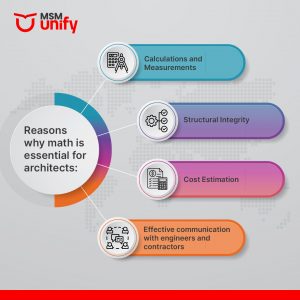What is Math in architecture?
The answer to this question depends on your aptitude and interest in studying mathematics. If you find math easy and enjoyable, it is recommended to take as many math subjects as possible while pursuing an architecture program. Mathematics for architects provides a strong foundation for problem-solving skills and opens doors to a variety of job roles. However, every university offers different types of side courses, so it is advisable to get in touch with an overseas education consultant for a better understanding. However, if math is not your strong suit, it is important to check the entrance architecture math requirements of your preferred college or university and fulfill the minimum criteria. Keep in mind that you will also need to take other subjects to study architecture. While studying math in Architecture, it is crucial to work hard and strive for the best grades possible. However, it is equally important not to overload yourself with extra math if you can achieve better grades in other relevant subjects. Focus on achieving a balance that allows you to excel in all areas of your studies.Why do you need math as an architect?
- Mathematics for architects is essential as it helps them with calculations and measurements in designing structures.
- Architects need to understand mathematical concepts such as geometry, trigonometry, and algebra to create accurate plans and drawings.
- Math is used to calculate dimensions, proportions, and scale in architectural designs.
- Mathematics for architects is used to analyze structural integrity and determine the load-bearing capacities of buildings.
- Math is also important in estimating costs and materials needed for construction projects.
- By having a strong foundation in math, architects can effectively communicate and collaborate with engineers, contractors, and other professionals involved in the construction process.

Types of Math in Architecture
Mathematics plays a crucial role in the field of architecture, providing architects with the tools and knowledge needed to create precise and functional designs. Here are some key courses regarding mathematics for architects:Algebra, Trigonometry, and Geometry
- Calculus requires the study of Algebra, Geometry, and Trigonometry, and it is required to complete an architecture degree program.
- Most students finish their Algebra, Geometry, and Trigonometry requirements in high school and can begin Calculus classes in college right away.
- Students who did not study Geometry and Algebra II with Trigonometry in high school must take those or related courses in college.
Calculus
- The study of mathematical change is known as Calculus. According to the College Board’s “Book of Majors,” architectural students are required to accomplish numerous calculus classes since they teach building design based on a sequence of construction specifications.
- Students must complete engineering calculus classes to learn how to properly position electrical elements, ventilation, and heating ducts, among other things.
- Calculus and physics classes assist students in calculating structural problems so that they may design structures that can bear the weight of materials and resist interior and exterior forces.
Probability and Statistics
- Certain architectural degree programs require students to take a probability and statistics math curriculum, which aids architects in analyzing data such as geological and geographic data, structural specifications, and construction management.
- Architects frequently use statistical analysis to evaluate the best value for money when estimating labor, materials, and machinery expenses.
- Architects can use computer software and modeling programs to swiftly and effectively examine actual data so they can make informed real-world judgments.
Linear Programming
- Students learn to assess variable elements that affect design and construction in linear programming classes.
- Linear programming, for example, allows architects to decide whether the expense of a certain design component will pay off in the long run or if it is excessively expensive for its function and purpose.
- Since architects frequently build structures within budgetary limits, linear programming allows for cost and outcome analyses. Linear programming courses may be classified in the math department or the technology department, depending on the university.
Finite Math
- In contrast to calculus, finite math necessitates analytical thinking rather than an emphasis on mathematical change.
- To learn how to develop mathematical models and calculate probability and statistical equations, architectural students complete a sequence of finite math classes.
- You’ll also learn about the relationship among design, construction, as well as the profit potential.
- Most importantly, this course teaches you how to combine all of the elements of your designs into a single cohesive product that can be transformed into a physical structure.
Essential courses and programs for mathematics for architects
Many top-ranking universities situated in top study destinations around the world offer comprehensive mathematics programs for aspiring architects. Here are some notable educational institutions that offer courses in mathematics for architects:United States:
- Massachusetts Institute of Technology (MIT): This US-based prestigious institution provides courses in differential equations, calculus, and linear algebra for architectural applications.
- Harvard University: Offers a wide range of courses, such as architectural calculus, statistics, and advanced geometry.
United Kingdom
- University College London (UCL): Recognized for its interdisciplinary way of learning, this institute offers courses in geometry, trigonometry, and structural mathematics.
- University of Cambridge: Provides tailored courses in mathematical methods for architecture, inclusive of probability and statistics.
Canada
- University of Toronto: Offers a wide range of programs for mathetics for architects including finite math, calculus, and linear programming.
- McGill University: Provides math in architecture programs in advanced algebra, geometry, and statistical analysis.
Australia
- University of Melbourne: Known for its innovative curriculum, including courses in trigonometry, calculus, and mathematical modeling for architecture.
- University of Sydney: Offers a program focusing on structural mathematics, probability, and computational methods for architecture.



























